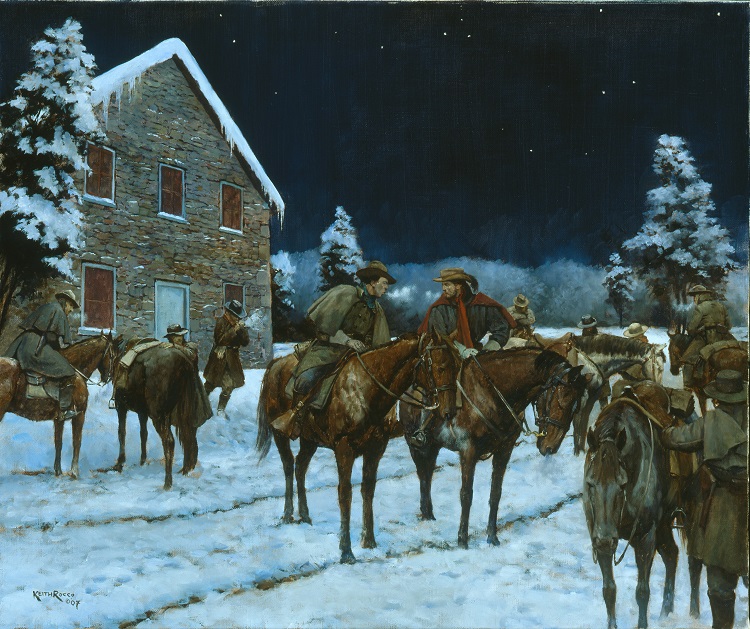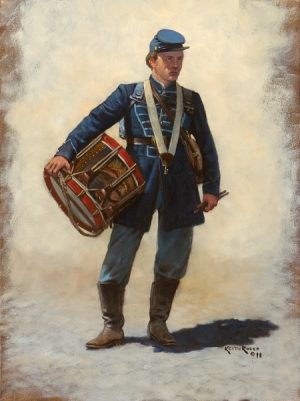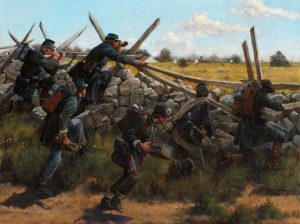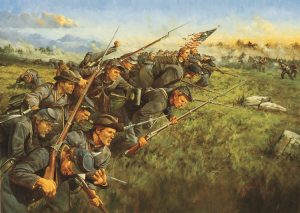Mosby’s Rangers
Description
200 signed and numbered prints
During the last twenty-seven months of the Civil War, a group of Confederate raiders, operating in northern Virginia, brought fear and dread to any Union soldiers stationed near the area. The leader of this band was John Singleton Mosby, a native Virginian and a lawyer by training. With no martial background, he began his military service as a private in the 1st Virginia Cavalry, but was quickly recognized by Jeb Stuart for his scouting abilities. In late April 1862 Mosby joined Stuart’s staff as a volunteer scout, and eight months later Stuart sent him with fifteen men to Loudoun and Fauqier counties to harass the troops protecting the Union capital. Mosby quickly recruited sufficient men to organize the first company of the 43rd Battalion, Virginia Partisan Rangers, and by the end of the war he commanded an eight-company regiment. Mosby’s Rangers used every advantage available to make their attacks a success.
In early January 1864, Frank Stringfellow, another of Stuart’s daring and resourceful scouts, contacted Mosby about capturing the camp of the Major Henry Cole’s Maryland cavalry, on Loudoun Heights, just across the Shenandoah River from Harpers Ferry. Mosby agreed, and late on the night of January 9, 1864, Mosby and approximately 100 men met Stringfellow about five miles from Harpers Ferry. It was an appropriate night for a raid. There was between six and twelve inches of snow on the ground, and the temperature was below freezing, with the wind driving the chill lower. During the march many of the men dismounted and walked beside their horses to circulate the blood in their legs and feet. Some slide their hands under their saddle blankets for warmth. About midnight Mosby met Stringfellow near St. Paul’s Church, some three miles south of Loudoun Heights. The religious sanctuary was the perfect location for a rendezvous; close enough that the target could be easily reached, but yet sufficiently distant that the raiders did not have to worry about a surprise visit from Union troops. While the leaders discussed the operation and the chances of success, the men continued their efforts to get warm; walking, smoking their pipes, and huddling together.
Within thirty minutes of arriving at the church, the Southerners departed for their rendezvous with fate. All the elements for a successful raid were in their favor, weather, darkness and surprise, but it was a failure, and after a savage fight, the raiders withdrew suffering heavy losses. Seven of the Confederates were killed or mortally wounded, the highest number of deaths in a raid, five were wounded, and one captured. As Mosby wrote in his report, “My loss was severe; more so in the worth that the number of the slain.” Two of his top leaders, Thomas Turner from Maryland, and William Smith from Fauquier County were killed. Another young officer of potential, William Colston, was also killed, as was John Robinson, a former captain in the British army.
Mosby and his Rangers recovered from the ill-fortune of this operation, and continued to attack and harass the Union troops in northern Virginia and the Shenandoah Valley until the end of the war.
– Horace Mewborn
Additional information
| Medium | |
|---|---|
| Size | 20" x 24" |
| Type |





